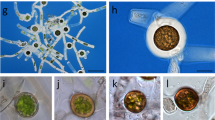Summary
The investigation of the formation of cell wall appendages inAcanthosphaera by means of light and electron microscopy and by the use of dyes which interfere with microfibril assembly resulted in several observations which are helpful to an understanding of the formation of normal cell walls. The barbs are built up in the ER, pass through the Golgi apparatus, and are extruded exocytotically after cytokinesis, a remarkable example of the secretion of a structured product. Each cellulose microfibril in a spike develops in a distinct pit of the plasmalemma. The pits are aggregated in a pit field, generating one spike, and are closely adjacent to a basal vesicle which might have morphogenetic and/or regulatory functions. The pits are the site of cellulose synthesis; here the plasmalemma is conspicuously thickened. As shown directly and by the application of Calcofluor white and Congo red, the microfibrils assemble at a certain distance from the plasma membrane,i.e. cellulose synthesis and microfibril assembly are separated by a gap. It is discussed whether single glucan chains or small bundles of them are released from the plasmalemma. The elongation rate of the spikes indicates that about 1000 glycosidic linkages per glucan chain per minute are formed.
Similar content being viewed by others
References
Benziman, M., Haigler, C. H., Brown, R. M., Jr., White, A. R., Cooper, K. M., 1980: Cellulose biogenesis: polymerization and crystallization are coupled processes inAcetobacter xylinum. Proc. nat. Acad. Sci. USA77, 6678–6682.
Bouck, G. B., 1971: The structure, origin, isolation, and composition of the tubular mastigonemes of theOchromonas flagellum. J. Cell Biol.50, 362–384.
Brown, R. M., Jr., 1979: Biogenesis of natural polymer systems with special reference to cellulose assembly and deposition. In: Structure and biochemistry of natural biological systems. Proc. 3. P. Morris Sci. Sympos. 1978 (Walk, E. M., ed.), pp. 52–123. New York: P. Morris. 1979.
Brown, R. M., Jr., Willison, J. H. M., Richardson, C. L., 1976: Cellulose biosynthesis inAcetobacter xylinum: visualization of the site of synthesis and direct measurement of thein vivo process. Proc. nat. Acad. Sci. USA73, 4565–4569.
Domozych, D. S., Rogers, C. E., 1981:In vivo cell wall ontogenesis in green algal flagellates. Plant Physiol.67, Suppl., 97.
Giddings, T. H., Jr., Brower, D. L., Staehelin, L. A., 1980: Visualization of particle complexes in the plasma membrane ofMicrasterias denticulata associated with the formation of cellulose fibrils in primary and secondary cell walls. J. Cell Biol.84, 327–339.
Haigler, C. H., Brown, R. M., Jr., Benziman, M., 1980: Calcofluor White ST alters thein vivo assembly of cellulose microfibrils. Science210, 903–906.
Heath, I. B., 1974: A unified hypothesis for the role of membrane bound enzyme complexes and microtubules in plant cell wall synthesis. J. theor. Biol.48, 445–449.
Hepler, P. K., 1980: Membranes in the mitotic apparatus of barley cells. J. Cell Biol.86, 490–499.
Herth, W., 1979: The site of β-chitin fibril formation in centric diatoms. II. The chitin-forming cytoplasmic structures. J. Ultrastruct. Res.68, 16–27.
—, 1980: Calcofluor white and Congo red inhibit chitin microfibril assembly ofPoterioochromonas: evidence for a gap between polymerization and microfibril formation. J. Cell Biol.87, 442–450.
—,Schnepf, E., 1980: The fluorochrome, calcofluor white, binds oriented to structural polysaccharide fibrils. Protoplasma105, 129–133.
— —,Surek, B., 1982: The composition of the-spikes ofAcanthosphaera zachariasi (Chlorococcales): investigations with fluorescent lectins and with X-ray diffraction. Protoplasma110, 196–202.
Kiermayer, O., Dobberstein, B., 1973: Membrankomplexe dictyosomaler Herkunft als „Matrizen“ für die extraplasmatische Synthese und Orientierung von Mikrofibrillen. Protoplasma77, 437–451.
Montezinos, D., Brown, R. M., Jr., 1979: Cell wall biogenesis in Oocystis: experimental alteration of microfibril assembly and orientation. Cytobios23, 119–139.
Mueller, S. C., Brown, R. M., Jr., 1980: Evidence for an intramembrane component associated with a cellulose microfibril-synthesizing complex in higher plants. J. Cell Biol.84, 315–326.
— —,Scott, T. K., 1976: Cellulosic microfibrils: nascent stages of synthesis in a higher plant cell. Science194, 949–951.
Nicholls, K. H., 1980: On the validity of the genusEchinosphaeridium Lemm. (Chlorophyceae). Brit. phycol. J.15, 77–81.
Pickett-Heaps, J. D., Staehelin, L. A., 1975: The ultrastructure ofScenedesmus (Chlorophyceae). II. Cell division and colony formation. J. Phycol.11, 186–202.
Roberts, E.,Seagull, R. W.,Haigler, C.,Brown, R. M., Jr., 1982: Alteration of cellulose microfibril formation in eukaryotic cells: Calcofluor white interferes with microfibril assembly and orientation inOocystis apiculata. In preparation.
Roberts, K., 1974: Crystalline glycoprotein cell walls of algae: their structure, composition and assembly. Phil. Trans. R. Soc. Lond. B268, 129–146.
Schnepf, E., 1981: Spiny Chlorococcales: structure and function of cell wall appendages. In: Cell Walls 1981. Proc. 2. Cell Wall Meeting (Robinson, D. G., Quader, H., eds.), pp. 66–74. Stuttgart: Wiss. Verlagsges.
—,Deichgräber, G., 1969: Über die Feinstruktur vonSynura petersenii unter besonderer Berücksichtigung der Morphogenese ihrer Kieselschuppen. Protoplasma68, 85–106.
Schnepf, E., Deichgräber, G., Drebes, G., 1980 a: Morphogenetic processes inAttheya decora (Bacillariophyceae, Biddulphiineae). Pl. Syst.Evol,135, 265–277.
— —,Glaab, M., Hegewald, E., 1980 b: Bristles and spikes in Chlorococcales: ultrastructural studies inAcanthosphaera, Micractinium, Pediastrum, Polyedriopsis, Scenedesmus, andSiderocystopsis. J. Ultrastruct. Res.72, 367–379.
—,Röderer, G., Herth, W., 1975: The formation of the fibrils in the lorica ofPoteriochromonas stipitata: tip growth, kinetics, site, orientation. Planta125, 45–62.
Wada, M., Staehelin, L. A., 1981: Freeze-fracture observations on the plasma membrane, the cell wall and the cuticle of growing protonemata ofAdiantum capillus-veneris L. Planta151, 462–468.
Author information
Authors and Affiliations
Rights and permissions
About this article
Cite this article
Schnepf, E., Deichgräber, G. & Herth, W. Development of cell wall appendages inAcanthosphaera zachariasi (Chlorococcales): Kinetics, site of cellulose synthesis and of microfibril assembly, and barb formation. Protoplasma 110, 203–214 (1982). https://doi.org/10.1007/BF01283323
Received:
Accepted:
Issue Date:
DOI: https://doi.org/10.1007/BF01283323




